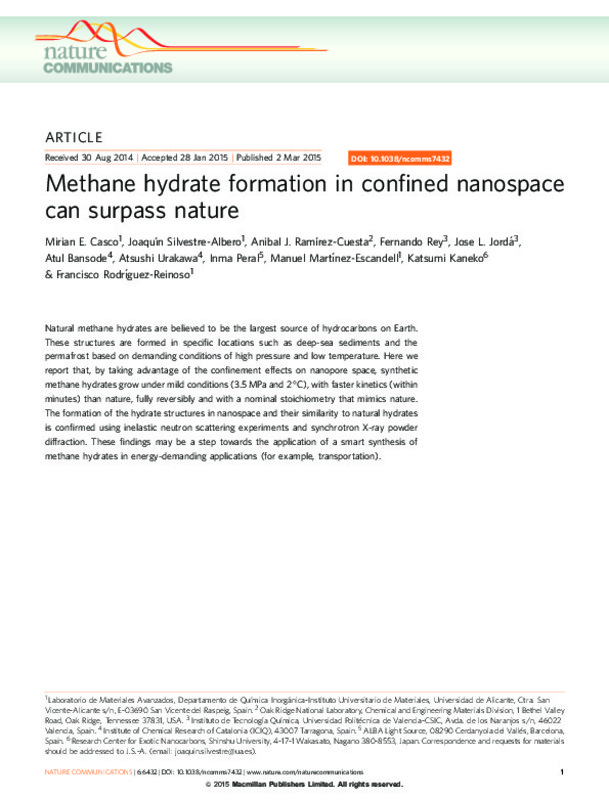Sloan, E. D. Jr., & Koh, C. A. Clathrate Hydrates of Natural Gases 3rd edn CRC Press (2007).
Gutt, C. et al. The structure of deuterated methane-hydrate. J. Chem. Phys. 113, 4713–4721 (2000).
Holbrook, W. S., Hoskins, H., Wood, W. T., Stephen, R. A. & Lizarralde, D. Methane hydrate and free gas on the Blake Ridge from vertical seismic profiling. Science 273, 1840–1843 (1996).
[+]
Sloan, E. D. Jr., & Koh, C. A. Clathrate Hydrates of Natural Gases 3rd edn CRC Press (2007).
Gutt, C. et al. The structure of deuterated methane-hydrate. J. Chem. Phys. 113, 4713–4721 (2000).
Holbrook, W. S., Hoskins, H., Wood, W. T., Stephen, R. A. & Lizarralde, D. Methane hydrate and free gas on the Blake Ridge from vertical seismic profiling. Science 273, 1840–1843 (1996).
Sloan, E. D. Jr., Fundamental principles and applications of natural gas hydrates. Nature 426, 353–363 (2003).
Rodríguez-Reinoso, F., Almansa, C. & Molina-Sabio, M. Contribution to the evaluation of density of methane adsorbed on activated carbon. J. Phys. Chem. B 109, 20227–20231 (2005).
Kockrick, E. et al. Ordered mesoporous carbide derived carbons for high pressure gas storage. Carbon 48, 1707–1717 (2010).
Klein, N. et al. A mesoporous metal-organic framework. Angew. Chem. Int. Ed. 48, 9954–9957 (2009).
Makal, T. A., Li, J.-R., Lu, W. & Zhou, H.-C. Methane storage in advanced porous materials. Chem. Soc. Rev. 41, 7761–7779 (2012).
Peng, Y. et al. Methane storage in metal-organic frameworks: Current records, surprise findings, and challenges. J. Am.Chem. Soc. 135, 11887–11894 (2013).
Casco, M. E. et al. High-pressure methane storage in porous materials: are carbon materials in the pole position? Chem. Mater 27, 959–964 (2015).
Ramos-Fernández, J. M., Martínez-Escandell, M. & Rodríguez-Reinoso, F. Production of binderless activated carbon monoliths by KOH activation of carbon mesophase materials. Carbon 46, 384–386 (2008).
Marsh, H. & Rodríguez-Reinoso, F. Activated Carbon Elsevier (2006).
Kubo, T. et al. Diffusion-barrier-free porous carbon monoliths as a new form of activated carbon. ChemSusChem 5, 2271–2277 (2012).
Kaneko, K., Itoh, T. & Fujimori, T. Collective interactions of molecules with an interfacial solid. Chem. Lett. 41, 466–475 (2012).
Nakamura, M., Ohba, T., Branton, P., Kanoh, H. & Kaneko, K. Equilibrium-time and pore-width dependent hysteresis of water adsorption isotherm on hydrophobic microporous carbons. Carbon 48, 305–308 (2010).
Vysniauskas, A. & Bishnoi, P. R. A kinetic study of methane hydrate formation. Chem. Eng. Sci. 38, 1061–1072 (1983).
Junhong, Q. & Tianmin, G. Kinetics of methane hydrate formation in pure water and inhibitor containing systems. Chin. J. Chem. Eng 10, 316–322 (2002).
Liu, J., Zhou, Y., Sun, Y., Su, W. & Zhou, L. Methane storage in wet carbon of tailored pore sizes. Carbon 49, 3731–3736 (2011).
Perrin, A., Celzard, A., Marêché, J. F. & Furdin, G. Methane storage within dry and wet activated carbons: a comparative study. Energy Fuels 17, 1283–1291 (2003).
Zhou, L., Liu, L., Su, W., Sun, Y. & Zhou, Y. Progress in studies of natural gas storage with wet adsorbents. Energy Fuels 24, 3789–3795 (2010).
Celzard, A. & Marêché, J. F. Optimal wetting of activated carbons for methane hydrate formation. Fuel 85, 957–966 (2006).
Webb, E. B. et al. High pressure rheology of hydrate slurries formed from water-in-oil emulsions. Energy Fuels 26, 3504–3509 (2012).
Urita, K. et al. Confinement in carbon nanospace-induced production of KI nanocrystals of high-pressure phase. J. Am. Chem. Soc. 133, 10344–10347 (2011).
Fujimori, T. et al. Conducting linear chains of sulphur inside carbon nanotubes. Nat. Commun. 4, 2162 (2013).
Tse, J. S., Ratcliffe, C. L., Powell, B. M., Sears, V. F. & Handa, Y. P. Rotational and translational motions of trapped methane. Incoherent inelastic neutron scattering of methane hydrate. J. Phys. Chem. A 101, 4491–4495 (1997).
Gutt, C. et al. Quantum rotations in natural methane-clathrates from the Pacific sea-floor. Europhys. Lett. 48, 269–275 (1999).
Stern, L. A., Kirby, S. H. & Durham, W. B. Peculiarities of methane clathrate hydrate formation and solid-state deformation, including possible superheating of water ice. Science 273, 1843–1848 (1996).
Gutt, C. et al. The structure of deuterated methane hydrate. J. Chem. Phys. 113, 4713–4721 (2000).
Everett, S. M. et al. Kinetics of methane hydrate decomposition studies via in situ low temperature X-ray powder diffraction. J. Phys. Chem. A 117, 3593–3598 (2013).
Miyawaki, J. et al. Macroscopic evidence of enhanced formation of methane nanohydrates in hydrophobic nanospaces. J. Phys. Chem. B 102, 2187–2192 (1998).
[-]









